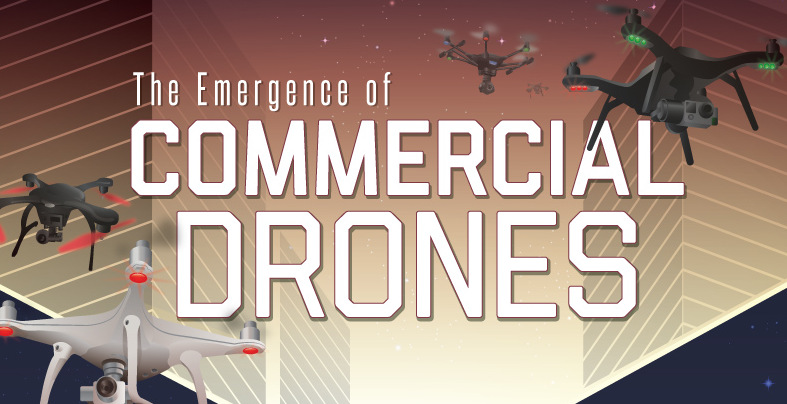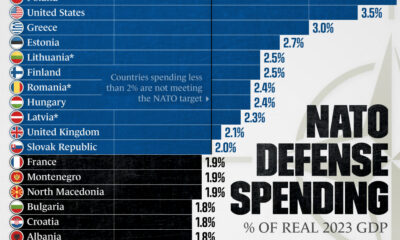Technology
The Emergence of Commercial Drones
Unmanned aerial vehicles (UAVs), commonly known as drones, have actually been around for about a century.
Even in 1918, the U.S. military had its first UAV, which acted as a “cruise missile” in combat. Nicknamed the Kettering Bug, it was essentially a flying bomb with 12-foot wings made of cardboard and paper mâché, running off a 40-horsepower Ford engine.
As you might imagine, the military has been a catalyst over the years for the development of UAV technology, which has allowed commercial drones to become cheaper, lighter, and more sophisticated. Today, drones aren’t just for delivering military payloads in foreign lands – UAVs will also be delivering your packages, taking photos, providing wireless internet services, and monitoring conservation efforts in remote locations.
The Commercial Drones Market
The following infographic comes to us from IFLY, a Drone Economy Strategy ETF focusing on the “development, research, and utilization of drones”.
It shows the history of military drone applications, and how that has led to today’s emerging market for commercial drones.

According to BI Intelligence, the total drone market today is close to $10 billion.
And despite the military market remaining the largest for now, it is worth noting that the commercial drone sector will grow at a compound annual growth rate (CAGR) of 19% between 2015 and 2020. Eventually, it will pass the military market in size, as that is only growing at a 5% clip.
The Emerging Opportunity for Commercial Drones
The growing market on the civilian side will impact a variety of industries, including private security, law enforcement, real estate, media, film, construction, mining, agriculture, and utilities.
Hardware for commercial drones is important, especially in the early stages. However, as we see in other sectors, it will likely be the software that makes the difference in many applications. As it becomes cheaper to customize commercial drones, the door will be opened to allow new functionality in a wide array of niche spaces. Sophisticated drones could soon be doing everyday tasks like fertilizing crop fields on an automated basis, monitoring traffic incidents, surveying hard-to-reach places, or even delivering pizzas.
At the end of the day, the impact of commercial drones could be $82 billion and a 100,000 job boost to the U.S. economy by 2025.
Technology
Visualizing AI Patents by Country
See which countries have been granted the most AI patents each year, from 2012 to 2022.

Visualizing AI Patents by Country
This was originally posted on our Voronoi app. Download the app for free on iOS or Android and discover incredible data-driven charts from a variety of trusted sources.
This infographic shows the number of AI-related patents granted each year from 2010 to 2022 (latest data available). These figures come from the Center for Security and Emerging Technology (CSET), accessed via Stanford University’s 2024 AI Index Report.
From this data, we can see that China first overtook the U.S. in 2013. Since then, the country has seen enormous growth in the number of AI patents granted each year.
| Year | China | EU and UK | U.S. | RoW | Global Total |
|---|---|---|---|---|---|
| 2010 | 307 | 137 | 984 | 571 | 1,999 |
| 2011 | 516 | 129 | 980 | 581 | 2,206 |
| 2012 | 926 | 112 | 950 | 660 | 2,648 |
| 2013 | 1,035 | 91 | 970 | 627 | 2,723 |
| 2014 | 1,278 | 97 | 1,078 | 667 | 3,120 |
| 2015 | 1,721 | 110 | 1,135 | 539 | 3,505 |
| 2016 | 1,621 | 128 | 1,298 | 714 | 3,761 |
| 2017 | 2,428 | 144 | 1,489 | 1,075 | 5,136 |
| 2018 | 4,741 | 155 | 1,674 | 1,574 | 8,144 |
| 2019 | 9,530 | 322 | 3,211 | 2,720 | 15,783 |
| 2020 | 13,071 | 406 | 5,441 | 4,455 | 23,373 |
| 2021 | 21,907 | 623 | 8,219 | 7,519 | 38,268 |
| 2022 | 35,315 | 1,173 | 12,077 | 13,699 | 62,264 |
In 2022, China was granted more patents than every other country combined.
While this suggests that the country is very active in researching the field of artificial intelligence, it doesn’t necessarily mean that China is the farthest in terms of capability.
Key Facts About AI Patents
According to CSET, AI patents relate to mathematical relationships and algorithms, which are considered abstract ideas under patent law. They can also have different meaning, depending on where they are filed.
In the U.S., AI patenting is concentrated amongst large companies including IBM, Microsoft, and Google. On the other hand, AI patenting in China is more distributed across government organizations, universities, and tech firms (e.g. Tencent).
In terms of focus area, China’s patents are typically related to computer vision, a field of AI that enables computers and systems to interpret visual data and inputs. Meanwhile America’s efforts are more evenly distributed across research fields.
Learn More About AI From Visual Capitalist
If you want to see more data visualizations on artificial intelligence, check out this graphic that shows which job departments will be impacted by AI the most.
-

 Mining1 week ago
Mining1 week agoGold vs. S&P 500: Which Has Grown More Over Five Years?
-

 Markets2 weeks ago
Markets2 weeks agoRanked: The Most Valuable Housing Markets in America
-

 Money2 weeks ago
Money2 weeks agoWhich States Have the Highest Minimum Wage in America?
-

 AI2 weeks ago
AI2 weeks agoRanked: Semiconductor Companies by Industry Revenue Share
-

 Markets2 weeks ago
Markets2 weeks agoRanked: The World’s Top Flight Routes, by Revenue
-

 Countries2 weeks ago
Countries2 weeks agoPopulation Projections: The World’s 6 Largest Countries in 2075
-

 Markets2 weeks ago
Markets2 weeks agoThe Top 10 States by Real GDP Growth in 2023
-

 Demographics2 weeks ago
Demographics2 weeks agoThe Smallest Gender Wage Gaps in OECD Countries














